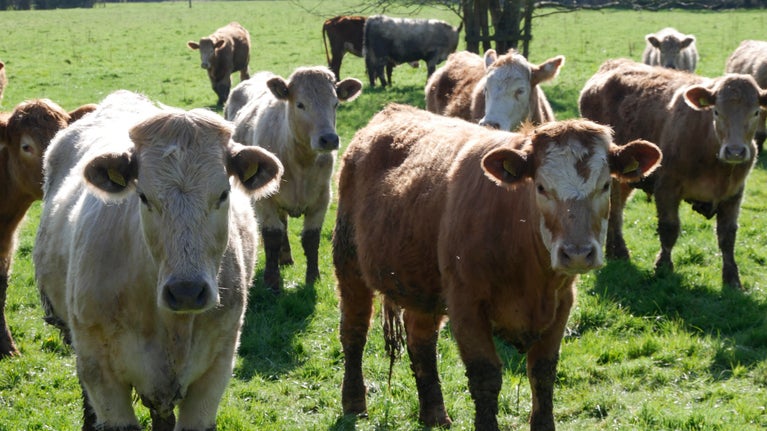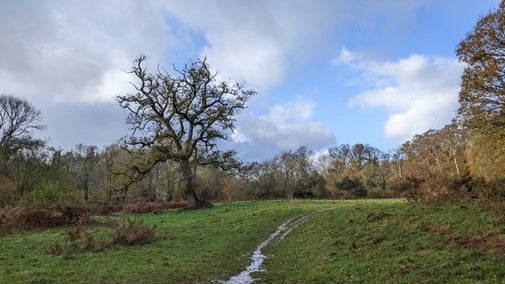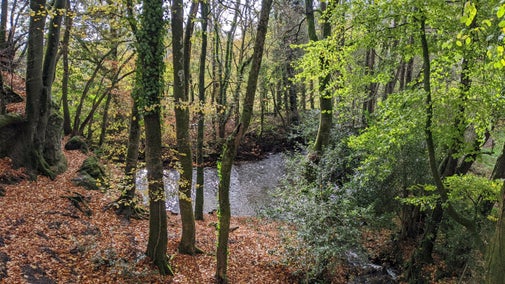
Donate
Everyone needs nature, now more than ever. Donate today and you could help people and nature to thrive at the places we care for.

From conservation grazing to woodland management, the ranger and Walled Garden teams at Parke work hard to look after this special place. Take a look at some of the work they do.
The grassland at Parke is a county wildlife site and therefore there are agreements in place such as ensuring the correct grazing by cattle. Cattle graze in a completely different way to sheep, which allows diverse flower rich swards to develop and by using hardy native livestock, rank and unpalatable grasses are reduced.
A local farmer and conservation grazier brings a small herd of cattle to Parke each year between mid-March and the end of April. Our mixed apple orchard is also grazed by native breeds of sheep for part of the year.
Please note, always follow the Countryside Code and keep dogs on a short lead when walking through areas with livestock.

Woodland management is incredibly important to keep habitats thriving. You may sometimes spot our ranger team felling trees, in order to enhance these areas.
We have been creating coppiced glades throughout the woodland. One of the key areas has been at the far end of the railway line. The trees have been felled, but no chemicals or after-treatment has taken place and they'll slowly but surely grow back.
This traditional coppice management replicates work that would have been undertaken by traditional woodland managers to produce charcoal. It creates successional habitat, which is beneficial to native wildlife, particularly butterflies.
In other areas of woodland we are undertaking thinning to improve light levels and species diversity. We are also targeting invasive species such as Rhododendron, Laurel and Himalayan Balsam.

Each autumn, the ranger team assess all the woodland areas at Parke for trees that could pose a risk to public safety.
Last year, much like other areas within the county, we have noticed a significant increase in trees suffering from ash dieback. Every effort is made to leave trees in non-public areas to see how they react to the disease and possibly even recover.
The ranger team survey the entire site every June, when the disease is most readily appparent. Badly infected trees are removed the following winter. Infected ash can become brittle very quickly and might pose a danger to visitors.
The Walled Garden is looked after by Bovey Community Gardeners and a band of National Trust volunteers. The community gardeners tend the large vegetable beds at the lower end of the garden, while the National Trust volunteers are busy cultivating the grape vines, herbaceous border and all the walled trained fruit.
We all try to be as sustainable as possible. Water to the garden comes from a well, rediscovered in 2007, and is pumped using solar power to a 10,000-litre tank which feeds all the taps. We never use any pesticides, relying instead upon hand removal of pests, supporting spaces for beneficial insects to thrive, or using biological pest control.
The herbaceous border, brimming with daisies and other open single flowered herbaceous plants, as well as a mix of annuals, attracts bees, butterflies and hoverflies to the garden to help pollinate the fruit and vegetable plants.
A number of different species of bat use Parke throughout the year. Two of the most important are the Greater Horseshoe and Lesser Horseshoe bats, who each use Parke in completely different ways.
The Lesser Horseshoe breed in the roof space of the old stables of Parke House and the roof space of the adjoining corner office. Thanks to the renovation works in recent years, the population has significantly increased to over 200 breeding females.
The Greater Horseshoe are here just for the winter and hide themselves away in the old gardener’s bothy, tucked behind the walled garden. In the spring, they go to the cave systems around Bovey Tracey and Buckfastleigh and meet up with females.
The appeal of Parke, especially to the Lesser Horseshoe, are the cattle-grazed grasslands, which provide lots of invertebrates for them to feed on.

Everyone needs nature, now more than ever. Donate today and you could help people and nature to thrive at the places we care for.
Explore the historic estate of Parke on the edge of Dartmoor, with its walled garden and mixed orchard plus abundant wildlife along the river.

The River Bovey runs through Parke and was an important source of water to power Bovey Tracey's historic mills sited downstream. Find out more about its history.

We believe that nature, beauty and history are for everyone. That’s why we’re supporting wildlife, protecting historic sites and more. Find out about our work.

Read about our strategy, which focuses on restoring nature, ending unequal access and inspiring more people.
